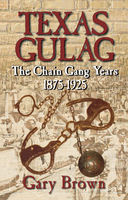Texas Gulag
The Chain Gang Years
1875-1925
Gary Brown

Library of Congress Cataloging-in-Publication Data
Brown, Gary., 1945
Texas Gulag : the chain gang years, 1875-1925 / Gary Brown.
p. cm.
Includes bibliographical references and index.
ISBN 1-55622-931-3
1. PrisonersTexasBiography. 2. ImprisonmentTexasCase studies.
3. PunishmentTexasCase studies. 4. TortureTexasCase studies.
5. PrisonsTexasHistory. I. Title.
HV9475.T4 B76 2002
365'.65dc21
2001058926
CIP
2002, Gary Brown
All Rights Reserved
Republic of Texas Press is an imprint of Wordware Publishing, Inc. No part of this book may be reproduced in any form or by any means without permission in writing from Wordware Publishing, Inc.
Printed in the United States of America
ISBN: 978-1-55622-931-2
10 9 8 7 6 5 4 3 2 1
0201
All inquiries for volume purchases of this book should be addressed to Wordware Publishing, Inc., at 2320 Los Rios Boulevard, Plano, Texas 75074. Telephone inquiries may be made by calling:
(972) 423-0090
Contents
Preface
Acknowledgments
1 Fourteen Years in Hell
2 Where Hogs Feasted on the Corpses of Convicts
3 Who Was John Henry and Why Do Inmates Call Him Johnnie?
4 The Texas Convict
5 Thirty-Nine Lashes with the Bat
6 The Man Who Fought the Brutality and Oppression of the Ring in the State of Texas for Eighteen Years and Won
7 Women in Chains
8 Necking on the Way to Prison
9 Sixteen Years at Huntsville
10 When the Sun Goes Down
11Schribners Monthly Report to the World
12 The Uncle with the Neck Chains
13 Run Like Hell, You Pitiful Soul
14 Long John Dunn of Taos
15 The Progressive Reporter from San Antonio
16 The Trans-Cedar Lynching and the Texas Penitentiary
17 The Infamous Calvert Coal Mines
18 Why the Aggies are Hated in Texas Prisons
19 25 Years Behind Prison Bars
20 Tools of Torture
21 Hell Exploded
22 Where, in Gods Name, Were the Prison Chaplains?
23 Lookout, Dawg Boy!
24 Seven Years in Texas Prisons
25 That First Night in the Pen
26 The Life of A.J. Walker, an Innocent Convict
27 What Was a Bertillion Officer?
28 Breakin Rocks in the Hot Sun, Texas Style
29 Buried Alive
30 Eating What a Dog Would Spurn
31 Twenty-Two Months in the Texas Penitentiary
32 Huntsvilles Dummy
33 Texas State Railroad
34 Twelve Years in a Texas Prison
Epilogue
Bibliography
Index
Preface
In 2000, less than a year after my retirement from the Texas Department of Criminal Justice, I was visiting an antique shop in Fowler, Colorado, and came upon a small and very old brochure titled Seven Years in Texas Prisons. After twenty-three years working in those prisons, I hardly wanted to read about them, but the age and appearance of the pamphlet intrigued me.
I purchased it, packed it away, and forgot about it until several weeks after Id returned home. When I finally sat down and read it, I was fascinated. It was a tiny 4-by-5-inch booklet only twenty-four pages in length, but in those pages, a former Texas prison convict named Beecher Deason wrote eloquently of the conditions inside Texas prisons in the early 1920s.
He wrote of the prison farms in the years immediately after the abolition of the convict lease system, and what he describedthe food, housing, punishments, building tenders, and brutalityportrayed a prison system I had heard about but never seen during my career.
Curious if any other convicts had written similar accounts of time in the early years of Texas prisons, I searched without success until I discovered a collection at the Center for American History at the University of Texas at Austin. They had several such narratives, and they dated back into the 1880s.
As I examined them, I found stories and accounts of serving time in Texas during the convict lease system when prisoners were leased out to private individuals and organizations to work in sawmills, on cotton plantations, and at railroad construction sites.
The pre-1900 accounts were particularly damning in their portrayal of brutality, and my first reaction was to dismiss them as attempts to get back at the prison system that had incarcerated these men.
Then, also at the Center for American History, I came upon a massive state report titled Report of the Penitentiary Investigating Committee including All Exhibits and Testimony Taken by the Committee, Published by Order of the House of Representatives, August 1910. This report was an official state document issued by the legislature, and in it I discovered almost all of the allegations in the various narratives by ex-prisoners had been found to be true.
The tiny brochure I had purchased in a Colorado antique shop led to my collecting prison narratives dating from 1875 to 1925a span of fifty years that can easily be classified as the most violent, brutal, and inhumane period of Texas correctional history.
The kept and the keepers have never seen eye-to-eye in the over 150 years of Texas prison history. And many times during that period, individuals, organizations, and state agencies have asked the question, Who guards the guards?
But it is the inmates who historically bear the greatest grudge against the system that incarcerates them.
During the late 1800s and the first decades of the following century, convicts unfortunate enough to be sentenced to Texas prisons and fortunate enough to survive to be paroled or discharged had few venues available to them in which to vent their anger and frustration at a system continuously in turmoil over charges of brutality and corruption.
The years leading up to the Great Depression were an extended period in which the Texas prison system was a state agency shrouded in secrecy. It would be many decades before convicts would have access to high profile media-oriented attorneys, sensational headline-seeking television investigative reporters, in-depth newspaper reports, and a federal judicial system that involved itself in Texas prison affairs from afar and without a clue as to how to solve the problems.
In essence, ex-convicts during the period of 1875 through 1925 had only one option available should they choose to try to inform the public about the brutality and corruption they claimed to have witnessed from inside Texas prisons.
They could write their memoirs.
And they did so, telling of the daily work quotas of seven tons of coal, three hundred pounds of cotton, or one and one-half cords of wood. They told of eating spoiled hog meat and sleeping on mattresses filled with bugs and filthy from sweat, blood, and dirt. They told of various punishments they endured, especially the hated bat that would be used in Texas prisons until the 1940s.
Texas Gulag: The Chain Gang Years 1875 - 1925 is a collection of those stories. Interspersed are detailed descriptions, many of which were taken directly from the 1910 Report of the Penitentiary Investigating Committee.
The inmates who wrote these accounts were obviously among the better-educated convicts of that period. But they, too, reflected the attitudes and prejudices of that fifty-year span. And they were criminals with an axe to grind.
Next page








